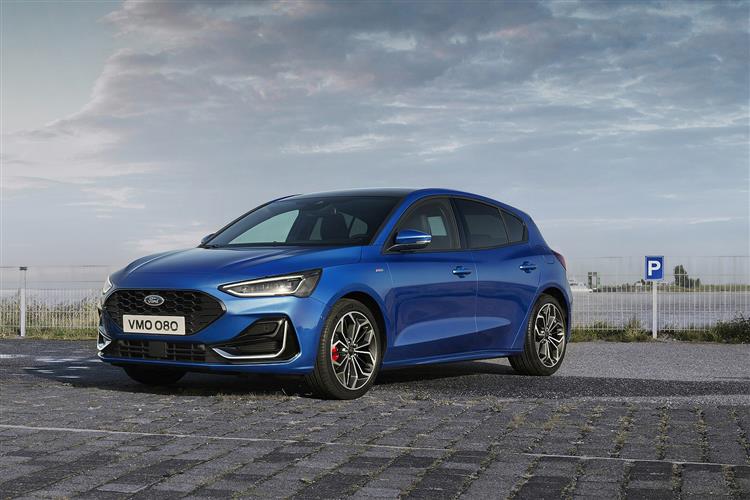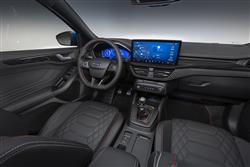How will you view?
This is a sample, and will stop after 30 seconds.
SHARPER FOCUS (some text hidden) SECTIONED_new_fordfocus_2022
By Jonathan Crouch
Ford has significantly improved the fourth generation version of its Focus. With smarter looks and extra technology, it'll still give its rivals plenty to think about, thinks Jonathan Crouch.
Ten Second Reviewword count: 71
The Ford Focus has evolved, this improved version of the MK4 model offering slicker looks, a much improved 'SYNC 4' infotainment system and extra technology. There's also impressive efficiency beneath the bonnet thanks to the hi-tech range of engines. The best part though, is that this car should still remain as rewarding to drive as it's always been. The Focus might have grown up but it certainly hasn't lost its spark.
Backgroundword count: 272
It's very difficult to over-state the importance of the Focus family hatch to Ford's European business. To understand its significance, press the rewind button for a moment and shuttle back to 1997. Ford's family hatch contender during this period was the fifth generation Escort, a car so all-encompassingly woeful that the brand was almost embarrassed to sell it. When the time came for a replacement, we all expected something better. What we got in the Focus model first launched in 1998 was something much, much more than that, a car that, at a stroke, offered arguably the biggest step forward in family car design the market has ever seen. Here at last was technology directed firmly at the man in the street who, in this apparently humble family hatchback, could experience a car more entertaining and rewarding to drive than almost anything this side of a sizeable lottery win. It was asking a lot for the MK2 model we saw in 2005 to repeat such a seismic step forward but that second generation Focus was still quite good enough to remain acclaimed as the driver's choice against rival Astras and Golfs that made up for their dynamic failings with a better ride and a more luxurious big car feel. These were attributes the Focus also needed and when it came to developing the MK3 version, launched early in 2011, Ford tried to provide them without compromising the car's class-leading handling. That's also been the goal with this more sophisticated MK4 model, announced in the Spring of 2018, then updated three years on to create the car we're going to look at here.
Driving Experienceword count: 355
There's one thing you always know about a Focus: which is that'll usually be a great steer. And of course nothing's changed in that regard with this updated model. As before, the ride isn't overly firm, but body control through the bends is still exemplary, allowing you at the wheel to make the most of the stiff C2 platform, the feelsome power steering and the torque vectoring control system that helps you get the power down through the bends. It all combines to create a car that really can still reward at the wheel, even in its most affordable forms: there's still nothing else in this segment that feels quite the same. Yet it still does the sensible stuff well too, being decently refined, with confident braking and a lovely tactile gearshift. The engine range was significantly updated as recently as 2020 with Ford's latest Mild Hybrid technology and of course that's carried forward, though the line-up kicks off with a conventional version of the brand's 1.0-litre EcoBoost petrol engine in 125PS form with a manual gearbox. You can have the same engine in mHEV mild hybrid form, though only if you're prepared to specify Ford's 7-speed PowerShift auto gearbox. The 155PS version of this mHEV mild hybrid 1.0-litre EcoBoost engine can be had with either manual or PowerShift auto transmission. Higher mileage drivers will be pleased to see that the 1.5-litre 120PS EcoBlue diesel engine's been retained in the range - though only with 8-speed auto transmission. And at the top of the line-up, the ST hot hatch continues on with the 280PS 2.3-litre EcoBoost petrol unit, offered with either manual or 7-speed auto transmission. One change we'd like to have seen relates to suspension. A little disappointingly, Ford continues to equip the lower-powered 1.0-litre petrol and 1.5-litre diesel Hatch variants that most customers choose with a cruder twist-beam damping set-up. If you want the more sophisticated independent rear double wishbone suspension system that improves ride comfort, you'll need an estate, the 'Active' crossover version or a more powerful hatch variant. The top 'ST' high performance version for instance, which gets stiffer, lowered suspension.
To see the full road test text contact us on 0330 0020 227
Pictures (high res disabled)

.jpg)
|
.jpg)
|
.jpg)
| |||
.jpg)
|

|
Statistics (subset of data only)
Min |
Max |
|
Price: |
£20,690.00 |
£30,385.00 |
Insurance group: |
5 |
20 |
CO2 (g/km): |
91 (TDCI 90) |
179 (ST 280) |
Max Speed (mph): |
110 (1.0 ECOBOOST 85) |
155 (ST 280) |
0-62 mph (s): |
5.7 (ST 280) |
12 (1.0 ECOBOOST 85) |
Combined Mpg: |
34.4 |
64.2 |
Length (mm): |
4378 |
4397 |
Width (mm): |
1979 |
|
Height (mm): |
1471 |
1502 |
... and 4 other stats available | ||
Scoring (subset of scores)
Category: Compact Family Cars
| Performance | |
| Handling | |
| Comfort | |
| Space | |
| Styling, Build, Value, Equipment, Depreciation, Handling, Insurance and Total scores are available with our full data feed. | |



